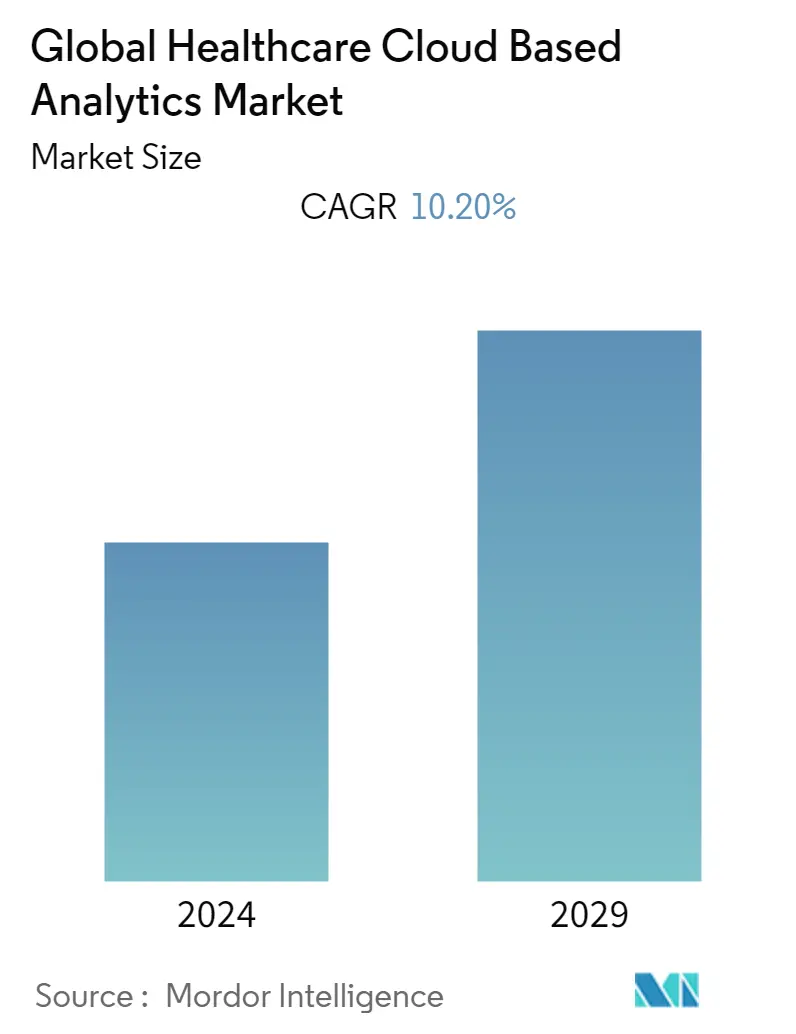Market Size of Global Healthcare Cloud Based Analytics Industry

| Study Period | 2019 - 2029 |
| Base Year For Estimation | 2023 |
| Forecast Data Period | 2024 - 2029 |
| CAGR | 10.20 % |
| Fastest Growing Market | Asia Pacific |
| Largest Market | North America |
| Market Concentration | Medium |
Major Players
*Disclaimer: Major Players sorted in no particular order |
Healthcare Cloud Based Analytics Market Analysis
The healthcare cloud-based analytics market is projected to register a CAGR of 10.2% during the forecast period (2022-2027).
The role of analytics increased significantly during the COVID-19 pandemic in the healthcare sector. For example, the analytics tools were widely used during the pandemic in the prediction of the incidence and severity of the infection in different parts of the world and, they played a crucial role in the containment of the pandemic and vaccine development against COVID-19. For instance, according to the research study published in March 2021, titled 'Applications of Big Data Analytics to Control COVID-19 Pandemic', the big data analytics technologies are essential for developing the knowledge needed to make judgments and take preventative action against any disease or pandemic, and amount of data grows significantly over time, particularly the data produced regarding the global epidemic brought on by COVID-19 and to make sense of the epidemic and quickly stop its spread, a large volume of data necessitates the use of big data analytics tools and artificial intelligence techniques. Further, the role of analytics tools is expected to increase as new variants of COVID-19 are being found and it is expected that COVID-19 would have a significant impact on the healthcare cloud-based analytics market.
The increasing digitalization in the healthcare industry (such as electronic health records, clinical data, and medical claims among others) is generating a huge amount of data, due to which the adoption and integration of big data analytics are increasing as the data generated need to be processed so that actionable insights can be generated and in this process, the data analytics tools play a significant role and hence, the demand for healthcare analytics tools is expected to increase over the forecast period, in which the cloud-based solutions would be a major one as they offer significant advantages over non-cloud solutions.
For instance, according to the research study published in July 2022, titled 'Big Data Analytics in Sustainable Healthcare Systems', big data analytics (BDA) can identify trends and transform highly voluminous electronic healthcare data into usable information so that informed decisions can be made to enhance patient care and further, the healthcare becomes a sustainable platform as a result of the development of data analytics and flexible techniques for handling, storing, and controlling user healthcare data.
Similarly, according to the research study titled 'The Use of Big Data Analytics in Healthcare', published in January 2022, the study was conducted in Poland on whether medical facilities in Poland use big data analytics and it was observed that the medical facilities work on both structured and unstructured data and in both the administrative and business realms as well as the clinical one, they turn to analytics for better insights. Also, as per the same source, big data analytics can improve healthcare globally and have a significant impact on improving patient care and the functioning of any medical facility. Hence, owing to the significant advantages of big data analytics in healthcare, their adoption is expected to increase over the forecast period and that is expected to fuel growth in the healthcare cloud-based analytics market.
Moreover, the technological advancement in the area is leading to the launch of new products from the companies operating in the market and, they are engaged in various other business activities for the development and expansion of their such as mergers and acquisitions, collaborations, licensing agreements, and others. These activities are further expected to boost market growth over the forecast period. For example, in March 2022, COPE Health Solutions and its Analytics for Risk Contracting (ARC) subsidiary signed a partnership agreement with CareJourney, and with this agreement, with the help of CareJourney's suite of cost and utilization benchmarks derived from Medicare and Medicaid datasets, COPE Health Solutions and its Analytics for Risk Contracting (ARC) subsidiary can offer health analytics platforms and solutions that integrate claims, electronic health records, lab, social determinants, and other data from a healthcare organization.
In addition, government initiatives in the area of adoption and use of big data analytics in healthcare are further expected to augment the growth of the studied market. For instance, a public dashboard for near real-time information on the Ayushman Bharat Digital Mission (ABDM), the National Health Authority's (NHA) flagship program, has been established by the Government of India, and the Ayushman Bharat Health Account (ABHA) numbers, Healthcare Professionals Registry (HPR), and Health Facility Registry are all displayed in detail on the ABDM public dashboard (HFR). Therefore, due to the above-mentioned factors, the healthcare cloud-based analytics market is expected to grow during the forecast period. However, security concerns regarding data privacy, initial deployment cost, and complexity of software are expected to restrain the growth of the studied market over the forecast period.
Healthcare Cloud Based Analytics Industry Segmentation
As per the scope of this report, cloud analytics refers to a service that helps to analyze the vivid evolution of cloud business models and demonstrates strategies and techniques for cloud services. Healthcare Cloud Based Analytics is used to achieve real-world, evidence-based decision-making authority. This is along with witnessing a constant development in patient health and hygiene, which is supported by the nourishment of patient care facilities. The healthcare cloud-based analytics market is segmented by technology type (predictive analytics, prescriptive analytics, and descriptive analytics), application (clinical data analytics, administrative data analytics, research data analytics, and others), component (hardware, and software), and geography (North America, Europe, Asia-pacific, Middle East and Africa, and South America). The market report also covers the estimated market sizes and trends for 17 different countries across major regions, globally. The report offers the value (in USD million) for the above segments.
| By Technology Type | |
| Predictive Analytics | |
| Prescriptive Analytics | |
| Descriptive Analytics |
| By Application | |
| Clinical Data Analytics | |
| Administrative Data Analytics | |
| Research Data Analytics | |
| Others |
| By Component | |
| Hardware | |
| Software |
| Geography | ||||||||
| ||||||||
| ||||||||
| ||||||||
| ||||||||
|
Global Healthcare Cloud Based Analytics Market Size Summary
The healthcare cloud-based analytics market is experiencing significant growth, driven by the increasing digitalization of the healthcare industry and the rising demand for data-driven insights. The COVID-19 pandemic highlighted the critical role of analytics in healthcare, as tools were essential for predicting infection trends and aiding in vaccine development. This surge in data generation from electronic health records, clinical data, and medical claims has propelled the adoption of big data analytics, particularly cloud-based solutions, which offer substantial advantages over traditional systems. The market is further bolstered by technological advancements, new product launches, and strategic partnerships among key players, which are enhancing the capabilities and reach of analytics tools in the healthcare sector.
North America is anticipated to hold a significant share of the healthcare cloud-based analytics market, with the United States leading due to its high healthcare expenditure and advanced digital infrastructure. The region's market growth is supported by the presence of major industry players and ongoing investments in healthcare information technology. Predictive analytics, a crucial component of the market, is expected to gain traction as it offers cost-reduction benefits and improves patient care. Despite challenges such as data privacy concerns and high initial costs, the market is poised for expansion, driven by government initiatives and the increasing need for efficient healthcare solutions.
Global Healthcare Cloud Based Analytics Market Size - Table of Contents
-
1. MARKET DYNAMICS
-
1.1 Market Overview
-
1.2 Market Drivers
-
1.2.1 Integration of Big Data into Healthcare
-
1.2.2 Technological Advancements in Data Analytics
-
1.2.3 Favorable Government Initiatives
-
-
1.3 Market Restraints
-
1.3.1 Data Privacy and Security Concern
-
1.3.2 Initial Cost and Complexity of Software
-
-
1.4 Porter's Five Forces Analysis
-
1.4.1 Threat of New Entrants
-
1.4.2 Bargaining Power of Buyers/Consumers
-
1.4.3 Bargaining Power of Suppliers
-
1.4.4 Threat of Substitute Products
-
1.4.5 Intensity of Competitive Rivalry
-
-
-
2. MARKET SEGMENTATION (Market Size by Value - USD million)
-
2.1 By Technology Type
-
2.1.1 Predictive Analytics
-
2.1.2 Prescriptive Analytics
-
2.1.3 Descriptive Analytics
-
-
2.2 By Application
-
2.2.1 Clinical Data Analytics
-
2.2.2 Administrative Data Analytics
-
2.2.3 Research Data Analytics
-
2.2.4 Others
-
-
2.3 By Component
-
2.3.1 Hardware
-
2.3.2 Software
-
-
2.4 Geography
-
2.4.1 North America
-
2.4.1.1 United States
-
2.4.1.2 Canada
-
2.4.1.3 Mexico
-
-
2.4.2 Europe
-
2.4.2.1 Germany
-
2.4.2.2 United Kingdom
-
2.4.2.3 France
-
2.4.2.4 Italy
-
2.4.2.5 Spain
-
2.4.2.6 Rest of Europe
-
-
2.4.3 Asia-Pacific
-
2.4.3.1 China
-
2.4.3.2 Japan
-
2.4.3.3 India
-
2.4.3.4 Australia
-
2.4.3.5 South Korea
-
2.4.3.6 Rest of Asia-Pacific
-
-
2.4.4 Middle East and Africa
-
2.4.4.1 GCC
-
2.4.4.2 South Africa
-
2.4.4.3 Rest of Middle East and Africa
-
-
2.4.5 South America
-
2.4.5.1 Brazil
-
2.4.5.2 Argentina
-
2.4.5.3 Rest of South America
-
-
-
Global Healthcare Cloud Based Analytics Market Size FAQs
What is the current Global Healthcare Cloud Based Analytics Market size?
The Global Healthcare Cloud Based Analytics Market is projected to register a CAGR of 10.2% during the forecast period (2025-2030)
Who are the key players in Global Healthcare Cloud Based Analytics Market?
HP, Oracle, Optum Health, Allscripts Healthcare, LLC and Oracle (Cerner Corporation) are the major companies operating in the Global Healthcare Cloud Based Analytics Market.

